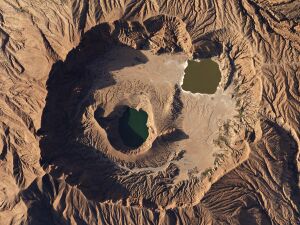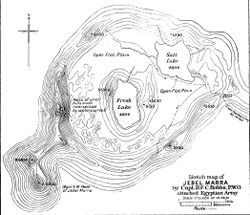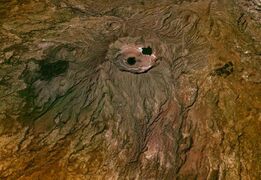Deriba (caldera)
Topic: Earth
 From HandWiki - Reading time: 8 min
From HandWiki - Reading time: 8 min
| Jebel Marra | |
|---|---|
 Deriba caldera, with the two lakes visible | |
| Highest point | |
| Listing | Country high point Ultra |
| Coordinates | Template:Coord/display/inline,intitle [1] |
| Geography | |
Lua error in Module:Location_map at line 408: Malformed coordinates value.
| |
Deriba is a Pleistocene or Holocene caldera in Darfur, Sudan. Part of the volcanoes of the Marra Mountains, it lies on the Darfur dome and like the Tagabo Hills and Meidob Hills volcanism may be the product of a mantle plume. After the separation of South Sudan, the highest point of Sudan is on the margin of the caldera.
The caldera lies atop a shield volcano or ash cone in the southern Marra Mountains, which developed first as a pile of basaltic lava flows and later as layers of volcanic ash and tuff, including the eruptions that formed the caldera. A large eruption occurred about 3,520 ± 100 years before present, and hot springs and fumaroles are active to the present day.
Deriba contains two lakes, one in the northeastern side of the main caldera and the other in a cone in the southwestern sector of the Deriba caldera. The fresher southwestern lake is smaller but considerably deeper than the saltier northeastern lake; in the late Pleistocene the caldera was filled with a larger lake.
Geography and geomorphology
Deriba lies in the Marra Mountains of Sudan,[2] Africa's geographic centre;[3] Deriba is in the southern sector of these mountains and close to the main summit thereof.[4] The caldera rim became Sudan's new highest point, after the independence of South Sudan.[5] The town of Nyala lies south of Deriba.[6] The volcano is poorly studied due to the ongoing Darfur conflict.[7]
Deriba is an oval, 4.8 by 6.4 kilometres (3 mi × 4 mi)[8] wide and 500–1,000 metres (1,600–3,300 ft) deep caldera, with a volcanic cone occupying the southwestern part of the caldera floor.[2] At least five overlapping vents form the volcanic cone.[9] The rim of the caldera reaches a maximum elevation of 3,024 metres (9,921 ft) in the southwest,[2] and is steep almost vertical.[10] The caldera is cut into volcanic ash, lapilli, lavas, obsidian and tuffs, and the floor is strewn with pumice blocks.[11][12] A gap lies in the eastern caldera wall.[13]
Lakes
Deriba contains two lakes, which are known as the "Deriba lakes". A 11.5-metre (38 ft) deep lake occupies the northeastern area of the caldera,[2] and being located in the lowest part of the caldera floor[14] it is the sink of Deriba.[11] In 1918 it had dimensions of 1,230 by 1,780 metres (1,350 yd × 1,950 yd), but by 1964 the size of the lake had increased.[15] The lake is surrounded by a gradually sloping muddy beach with the exception of the northern shore.[16] This lake is also known as the "female" lake, with green salty water.[8] The salt consists of chloride, potassium and sodium salts.[17]
The volcanic cone has a lake as well, which is 108 metres (354 ft) deep[2] and smaller, with a roughly rectangular shape that extends in north-south direction.[18] In comparison to the other lake 1.21 kilometres (0.75 mi) northwest, this "male" lake had dimensions of 820 by 1,420 metres (900 yd × 1,550 yd) in 1918. Steep slopes surround this lake,[8] which is filled with fresher water.[11] Reportedly, the local Fur people considered the lake haunted,[19] but the lakes were also used as a source for salt.[20]
Water levels in these lakes are fairly stable[21] from season to season[22] although evidence for substantial fluctuations have been found[15][23] that correlate to the regional climate and to fluctuations in the water levels of Lake Chad.[9] Together with several perennial streams they are thus perennial waterbodies.[24] Around the Deriba caldera, drainage occurs either southward or westward,[25] leading into the Bahr El-Arab of the White Nile and the Chari River of Lake Chad respectively.[3] The lakes themselves have no surface outlets.[26]
In the past, larger lakes existed inside the Deriba caldera. The first such lake stage has been dated to 23,000[27] or 19,000 years before present when water levels rose 25 metres (82 ft) above the present-day levels, the second 19,600 – 16,000 years before present when they were 8–5 metres (26–16 ft) higher than currently and the third 14,000 years before present, then 9 metres (30 ft) above present-day. Similar lake stages have been documented in Trou au Natron in Tibesti, where shifts of the position of the subtropical jet stream and the tropical depressions associated with the jet stream have been invoked as an explanation.[28][29] These lake stages have left shorelines[9] and limestone deposits in the caldera,[23] and it is likely that the lakes sometimes overflowed through the eastern caldera rim gap.[30]
Geology
Deriba is part of the Jebel Marra volcano, which together with the Tagabo Hills and the Meidob Hills is one of three volcanic fields in Darfur;[31] these form the little known Darfur Volcanic Province.[32] The Jebel Marra volcano is maximally 80 kilometres (50 mi) wide and 200 kilometres (120 mi) long in north-south direction, where the northern segment is centered around Jebel Gurgei.[6]
Jebel Marra consists of a pile of mostly basaltic lava which has been covered by pumice and volcanic ash as well as pyroclastic rocks and ignimbrites.[33] The Deriba caldera which forms the top of the entire complex,[34] which around Deriba has the appearance of a large ash cone[35] or shield volcano.[36] Other, less spectacular vents are found elsewhere in the Marra Mountains. Erosion has cut canyons into the volcanic complex.[37] The occurrence of volcanism has been explained with a mantle plume centered between Meidob and Jebel Marra.[38]
The basement is formed by crystalline rocks, mainly metamorphosed gneisses and schists,[39] and is a mobile belt of Panafrican age.[32] They are in part covered by the Nubian Sandstones of Cretaceous age and aeolian sands,[40] and by the Jebel Marra massif which occupies a surface of 13,000 square kilometres (5,000 sq mi).[34] Tectonic uplift of the Darfur dome commenced in the Cretaceous[41] and resulted in a noticeable upwarp of the basement beneath Jebel Marra.[33] Two major tectonic lineaments intersect at Jebel Marra,[40] one trending south-southeastward and the other east-northeastward.[42]
Eruptive history
Volcanism in the Jebel Marra mountains appears to have begin 15 million years ago and continued in two stages, separated by an erosional period.[43] Volcanism in the southwestern Marra mountains took place between 4.35 million years ago and 60,000 years ago,[36] subdivided into an Old Series and a New Series which is younger than 2 million years ago.[41] After an initial stage, during which olivine basalt and small amounts of pyroclastic material were erupted, trachyte were emplaced.[44] The Deriba caldera probably formed either in the early Pleistocene,[27] 60,000[41] or 3,520 ± 100 years before present (BP), but activity continued with the volcanic cone inside of the caldera and peripheral vents, possibly into historical time.[34]
The 3,520 ± 100 BP eruption was a Plinian eruption that deposited pyroclastic material containing blocks of basement material. The ash fall from the eruption reaches thicknesses of 20 metres (66 ft) as far as 5 kilometres (3.1 mi) away from Deriba,[33] while pyroclastic flows have been identified as far as 30 kilometres (19 mi) from the caldera. The eruption has an estimated volcanic explosivity index of 4[1] and may be associated with the volcanic cone inside the caldera.[23]
The volcano was formerly considered to be extinct.[45] Hot springs, whose temperature reaches 65–85 °C (149–185 °F) and which may be supplied by magmatic water,[45] and fumaroles, both within the caldera around the volcanic cone and in the surrounding Marra Mountains,[34][18] indicate that Jebel Marra and the Deriba caldera are a dormant volcano.[18] Reportedly, the exhalations of the fumaroles can kill birds and insects,[45] and some fumarolic vents may have formed between 1964 and 1966,[46] implying that the fumarolic activity may reflect a recent change of volcanic activity.[47]
Climate
Jebel Marra has a humid subtropical climate (Cwa) bordering on a subtropical highland climate (Cwb). Precipitation on Jebel Marra is about 1,200 millimetres per year (47 in/year),[48] the mountain lies at the eastern margin of the Sahel[29] and receives more precipitation than the surrounding region.[14] Between 12,000 and 8,000 years before present, the climate was wetter as a consequence of a northward shift of climate zones.[49]
Biology
Vegetation around Deriba consists of grassland with scarce trees such as the wild olive.[50] The plant life is classified as Afromontane, it also includes species from temperate climates.[48] It is likely that past humid periods permitted the expansion of Mediterranean species into the Jebel Marra mountains.[51] Presently, Jebel Marra is a suitable site for agriculture and used as such by the Fur people.[24][43] Semi-desert and desert landscapes dominate the region around the Marra Mountains.[14]
The lakes are salty, oxygen poor and remote and thus contain little plant or animal life.[52] Some vegetation grows around the smaller lake, as well as in other parts of the Deriba caldera where water is available.[21]
Copepods live in the smaller lake, while the larger one is populated by blue-green algae and rotifers.[18] Spirulina occurs in the large lake,[53] and Melosira and Nitzscia diatoms have been identified in the small lake.[54] The copepod Eucyclops gibsoni has been encountered in the small lake. Among the rotifers are Brachionus dimidiatus, Brachionus plicatilis, Hexarthra jenkinae[54] and Lecane bulla, some of which also occur in the smaller lake.[55] Ephedra flies are widespread around the large lake, and other insects were collected on the small lake.[56] Birds such as greenshanks, little grebes, sacred ibis and stilts are uncommon.[57]
Gallery
References
- ↑ 1.0 1.1 "Jebel Marra". Smithsonian Institution. https://volcano.si.edu/volcano.cfm?vn=225030.
- ↑ 2.0 2.1 2.2 2.3 2.4 Green, Moghraby & Ali 2009, p. 493.
- ↑ 3.0 3.1 Issawi, Bahay; Sallam, Emad S. (1 January 2017). "Rejuvenation of dry paleochannels in arid regions in NE Africa: a geological and geomorphological study" (in en). Arabian Journal of Geosciences 10 (1): 10. doi:10.1007/s12517-016-2793-z. ISSN 1866-7511.
- ↑ Gillan 1918, p. 263.
- ↑ Touring The Surprising Unseen Side Of Darfur - 1 May 2017, Forbes, Accessed on 6 May 2018.
- ↑ 6.0 6.1 Vail 1972, p. 251.
- ↑ Williams 2019, p. 187.
- ↑ 8.0 8.1 8.2 Gillan 1918, p. 265.
- ↑ 9.0 9.1 9.2 Williams 2019, p. 189.
- ↑ Williams 2019, p. 188.
- ↑ 11.0 11.1 11.2 Lynes & Lynes 1921, p. 123.
- ↑ Vail 1972, p. 259.
- ↑ Williams et al. 1980, p. 323.
- ↑ 14.0 14.1 14.2 Hammerton 1968, p. 136.
- ↑ 15.0 15.1 Hammerton 1968, p. 138.
- ↑ Hobbs 1918, p. 360.
- ↑ Fott, Bohuslav; Karim, Abdel G. A. (1973). "Spirulina plankton community in a lake in Jebel Marra, Sudan" (in English). Archiv für Protistenkunde 115: 409. ISSN 0003-9365.
- ↑ 18.0 18.1 18.2 18.3 Green, Moghraby & Ali 2009, p. 494.
- ↑ Hobbs 1918, p. 361.
- ↑ Hammerton 1968, p. 141.
- ↑ 21.0 21.1 Lynes & Lynes 1921, p. 124.
- ↑ Hammerton 1968, p. 139.
- ↑ 23.0 23.1 23.2 Williams et al. 1980, p. 305.
- ↑ 24.0 24.1 Vail 1972, p. 252.
- ↑ Vail 1972, p. 256.
- ↑ Hobbs 1918, p. 362.
- ↑ 27.0 27.1 Williams 2019, p. 191.
- ↑ Maley, J (November 2000). "Last Glacial Maximum lacustrine and fluviatile Formations in the Tibesti and other Saharan mountains, and large-scale climatic teleconnections linked to the activity of the Subtropical Jet Stream" (in en). Global and Planetary Change 26 (1–3): 126–127. doi:10.1016/S0921-8181(00)00039-4. ISSN 0921-8181. Bibcode: 2000GPC....26..121M.
- ↑ 29.0 29.1 Soulié-Märsche, I.; Bieda, S.; Lafond, R.; Maley, J.; M'Baitoudji; Vincent, P.M.; Faure, Hugues (July 2010). "Charophytes as bio-indicators for lake level high stand at "Trou au Natron", Tibesti, Chad, during the Late Pleistocene" (in en). Global and Planetary Change 72 (4): 339. doi:10.1016/j.gloplacha.2010.05.004. ISSN 0921-8181. Bibcode: 2010GPC....72..334S.
- ↑ Williams et al. 1980, p. 325.
- ↑ Wickens 1975, p. 110.
- ↑ 32.0 32.1 Franz et al. 1994, p. 614.
- ↑ 33.0 33.1 33.2 Francis, P. W.; Thorpe, R. S.; Ahmed, F. (14 May 1973). "Setting and Significance of Tertiary-Recent Volcanism in the Darfur Province of Western Sudan" (in En). Nature Physical Science 243 (124): 31. doi:10.1038/physci243030a0. ISSN 0300-8746. Bibcode: 1973NPhS..243...30F.
- ↑ 34.0 34.1 34.2 34.3 Wickens 1975, p. 112.
- ↑ Vail 1972, p. 258.
- ↑ 36.0 36.1 Franz et al. 1994, p. 618.
- ↑ Vail 1972, p. 253.
- ↑ Franz et al. 1994, p. 621.
- ↑ Vail 1972, p. 257.
- ↑ 40.0 40.1 Wickens 1975, p. 111.
- ↑ 41.0 41.1 41.2 Davidson, Jon P.; Wilson, Ian R. (October 1989). "Evolution of an alkali basalt—trachyte suite from Jebel Marra volcano, Sudan, through assimilation and fractional crystallization" (in en). Earth and Planetary Science Letters 95 (1–2): 146. doi:10.1016/0012-821X(89)90173-8. ISSN 0012-821X. Bibcode: 1989E&PSL..95..141D.
- ↑ Williams 2019, p. 178.
- ↑ 43.0 43.1 Williams 2019, p. 180.
- ↑ Newhall, Christopher G.; Dzurisin, Daniel (1983) (in en). U.S. Geological Survey Bulletin. U.S. Government Printing Office. p. 152.
- ↑ 45.0 45.1 45.2 "Hot Springs and Fumaroles at Jebel Marra, Sudan" (in En). Nature 209 (5030): 1290. 1966. doi:10.1038/2091290b0. ISSN 0028-0836. Bibcode: 1966Natur.209R1290..
- ↑ "Historical Unrest at Large Calderas of the World". p. 152. https://pubs.usgs.gov/bul/1855/report.pdf.
- ↑ Hammerton 1968, p. 143.
- ↑ 48.0 48.1 Wickens 1975, p. 109.
- ↑ Wickens 1975, p. 120.
- ↑ Lynes & Lynes 1921, p. 126.
- ↑ Wickens 1975, p. 118.
- ↑ Green, Moghraby & Ali 2009, p. 502.
- ↑ Green, Moghraby & Ali 2009, p. 497.
- ↑ 54.0 54.1 Green, Moghraby & Ali 2009, p. 498.
- ↑ Green, Moghraby & Ali 2009, p. 499.
- ↑ Green, Moghraby & Ali 2009, p. 500.
- ↑ Green, Moghraby & Ali 2009, p. 501.
Sources
- Franz, G.; Pudlo, D.; Urlacher, G.; Haussmann, U.; Boven, A.; Wemmer, K. (1 October 1994). "The Darfur Dome, western Sudan: the product of a subcontinental mantle plume" (in en). Geologische Rundschau 83 (3): 614–623. doi:10.1007/BF01083232. ISSN 0016-7835. Bibcode: 1994GeoRu..83..614F.
- Gillan, J. A. (1918). "Jebel Marra and the Deriba Lakes". Sudan Notes and Records 1 (4): 263–267.
- Green, J.; Moghraby, A. I. el; Ali, O. M. M. (20 August 2009). "Biological observations on the crater lakes of Jebel Marra, Sudan" (in en). Journal of Zoology 189 (4): 493–502. doi:10.1111/j.1469-7998.1979.tb03976.x. ISSN 0952-8369.
- Hammerton, D. (1968). "Recent Discoveries in the Caldera of Jebel Marra". Sudan Notes and Records 49: 136–148.
- Hobbs, H. F. C. (1918). "Notes on Jebel Marra, Darfur". The Geographical Journal 52 (6): 357–363. doi:10.2307/1780270. https://zenodo.org/record/2511726.
- Lynes, CAPTAIN R.N.; Lynes, CAPTAIN H.R.N. (1921). "Notes on the Natural History of Jebel Marra". Sudan Notes and Records 4 (3): 119–137.
- Vail, J. R. (1 March 1972). "Jebel Marra, a dormant volcano in Darfur Province, Western Sudan" (in en). Bulletin Volcanologique 36 (1): 251–265. doi:10.1007/BF02596994. ISSN 0366-483X. Bibcode: 1972BVol...36..251V.
- Wickens, G.E. (March 1975). "Quaternary plant fossils from the Jebel Marra volcanic complex and their palaeoclimatic interpretation" (in en). Palaeogeography, Palaeoclimatology, Palaeoecology 17 (2): 109–122. doi:10.1016/0031-0182(75)90049-8. ISSN 0031-0182. Bibcode: 1975PPP....17..109W.
- Williams, M.A.; Morton, W.H.; Parry, D.E.; Adamson, D.A.; Williams, F.M. (1980). "Jebel Marra volcano: a link between the Nile Valley, the Sahara, and Central Africa". https://www.cabdirect.org/cabdirect/abstract/19812608929.
- Williams, Martin (2019). The Nile Basin: Quaternary Geology, Geomorphology and Prehistoric Environments. Cambridge: Cambridge University Press. ISBN 978-1-107-17919-6. https://www.cambridge.org/core/books/nile-basin/77DE05D66A6B01EBB9511B9F41CEBB85.
External links
- Satellite image (large scale) : [1]
- Oblique aerial photo on page 27 (large scale) : [2]
- Deriba Caldera at NASA Earth Observatory
 |
 KSF
KSF




